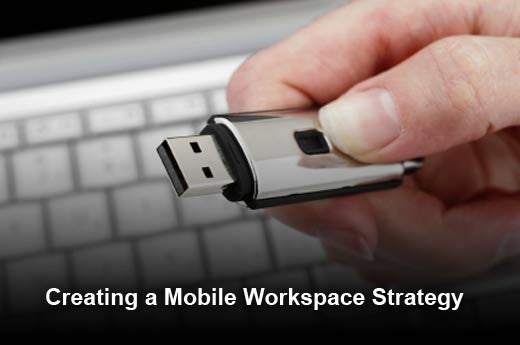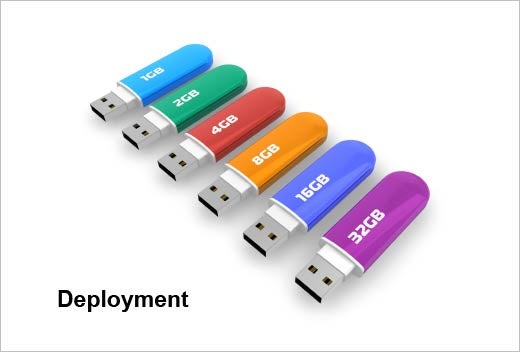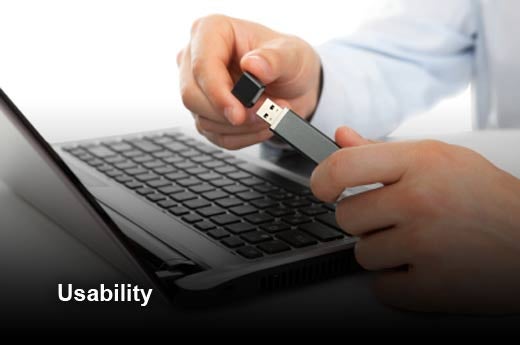“Remote work,” or teleworking, is an increasingly important concept as organizations attempt to become more flexible and agile while driving down costs. IDC reports that there are 1.3 billion mobile workers today; that number is expected to grow to 1.6 billion by 2015.
By enabling employees and contractors to have the same, seamless computing experience from any location and any computer, organizations can expect increased productivity. The U.S. and Canadian governments, among others, have become major proponents of the telework concept as a way to reduce costs, support “green” initiatives, and keep government open when access to the office is not an option.
The secure mobile workspace, or PC-on-a-stick portable desktop, holds the promise of allowing an IT organization to embrace worker mobility, workplace agility and “bring your own device” (BYOD) – while safeguarding data and network access with more granularity and security than with a corporate-provided computer.
This slideshow features five considerations, identified by Lawrence Reusing, general manager at Imation Mobile Security, that enterprises and SMBs need to consider as they develop and implement a mobile workspace strategy.

Click through for five factors businesses should take into consideration when developing a mobile workspace strategy, as identified by Lawrence Reusing, general manager at Imation Mobile Security.

A small form factor plays a large role in an organization’s ability to quickly distribute mobile workspace devices to end users. For example, with a secure mobile workspace, IT provisions a complete standard image of the operating system with all corporate applications onto a USB flash drive, to deliver a fully functional workspace-on-a-stick to the remote worker. Windows 8 Enterprise simplifies deployment even further by enabling IT to allow employees to create their own workspace on a certified USB flash drive using the Windows To Go feature.

As mobile computing devices become broadly distributed corporate assets, they need to be managed for accountability and security. The organization should be able to assign the devices to individuals automatically through Active Directory, a feature of Windows commonly leveraged by mobile workspaces. Additionally, it is important to be able to re-provision a device so that it can be used by another employee quickly.

Any mobile solution must provide staunch protection from data leakage. PC-on-a-stick mobile workspaces, for example, are designed to prevent data leaks by running entirely from the USB: No data can be copied to the host computer’s hard drive, and the device leaves no data footprint on the host computer.
Additionally, Imation, one of a handful of companies making USB devices certified for Windows To Go, is developing devices for Windows To Go that include hardware encryption, centralized management and other security enhancements.

Data at rest should be encrypted to avoid data leaks, public disclosure and the costly fines associated with government mandates such as HIPAA and PCI (relevant for organizations handling personal health and credit card information, respectively). Most secure mobile workspace solutions currently leverage Windows features such as BitLocker drive encryption to protect the drive’s contents and mitigate the risks of data loss or theft.

The solution needs to offer the user the same familiar experience on a computer at home or on the road that they have in the office. A mobile workspace product is ideal if it is able to take advantage of all of the hardware capabilities of the system that it is working on (Wi-Fi, video card, webcam, printers, external monitors, etc.). And unlike VPN solutions, a secure USB mobile workspace allows workers to access their data and applications without an Internet connection. This is especially important in cases where an Internet connection may not be available – during travel or in a disaster recovery situation. Lastly, an attractive and durable form factor for the mobile device encourages user adoption and protects it from the elements and unintentional abuse.
The secure mobile workspace, or PC-on-a-stick portable desktop, can be an ideal way for organizations to reap the financial and productivity benefits promised by the modern wave of teleworking. Keeping the above in mind will enhance their likelihood of success while doing so.














